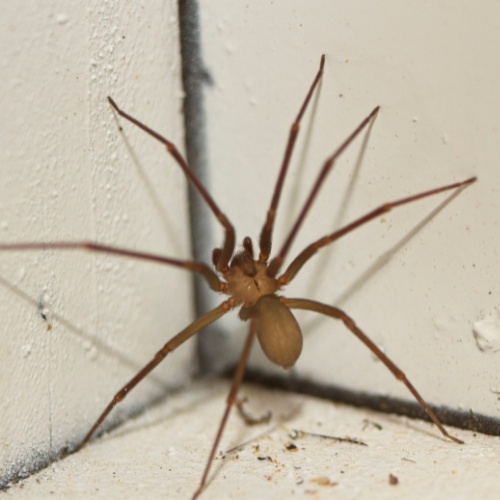
05 Jan Managing Brown Recluse Spider Risks
Habitat, Behavior & Key Characteristics
The brown recluse spider, a creature shrouded in much fear and intrigue, is frequently a topic of concern in pest control discussions. This blog post aims to demystify the brown recluse spider, exploring its actual danger level, identifying characteristics, habitat, behavior, and effective prevention strategies. Understanding these aspects is crucial for homeowners, outdoor enthusiasts, and anyone concerned about these often misunderstood arachnids.
Scientifically known as Loxosceles reclusa, is distinguished by several unique features. Typically, it exhibits a uniform brown color and has a distinct violin-shaped mark on its back, leading to its nickname, “fiddleback spider.” Adult brown recluses are usually about the size of a quarter, including their legs. They have six eyes arranged in pairs, which is unusual among spiders.
Brown recluse spiders thrive in warm, dry, and dark environments. They are commonly found in the South-Central United States, but their range can extend beyond this area. Indoors, they prefer undisturbed places like closets, basements, attics, and behind furniture. Outdoors, they are often found in woodpiles, sheds, and debris. Brown recluses are nocturnal and tend to avoid human interaction, biting only when threatened or pressed against the skin.
Dangers, Symptoms, and First Aid Treatment
While brown recluse spiders are venomous, their level of danger to humans is often exaggerated. Not all bites result in severe reactions; however, when they do, medical attention is crucial. A brown recluse bite may initially go unnoticed, with symptoms developing hours later. Symptoms can include pain, redness, swelling, and in more severe cases, necrosis (tissue death) around the bite site. Systemic reactions, although rare, can occur and are more severe.
In the event of a brown recluse spider bite, it is important to remain calm and seek medical attention. While awaiting care, the affected area should be washed with soap and water, and an ice pack can be applied to reduce swelling. Elevating the affected area may also help. Medical treatment varies based on the severity of the bite, ranging from pain management to treatments for more serious tissue damage.
Preventing Infestations
Prevention is key in managing brown recluse populations. Regular cleaning, reducing clutter, and sealing cracks and openings in buildings can deter these spiders from settling. Insecticides can be used in areas where spiders are likely to hide, but professional pest control services are often the most effective solution. These experts can provide targeted treatments and advice for long-term control.
Professional pest control services play a crucial role in managing brown recluse spider infestations. They offer expertise in identifying infestation signs, implementing effective control measures, and providing preventive recommendations. Regular inspections and targeted treatments by professionals can significantly reduce the risk of encountering these spiders in homes and workplaces.
While brown recluse spiders can pose a danger, understanding their behavior, habitat, and effective prevention strategies can significantly mitigate the risks. Homeowners should focus on prevention and be aware of the signs of infestation. In cases of severe infestations or bites, seeking professional medical and pest control assistance is essential. By demystifying these spiders and adopting proactive measures, we can coexist safely with them while minimizing risks.


No Comments